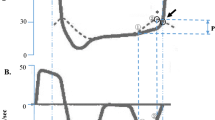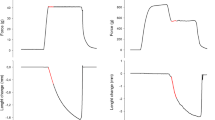Summary
The force—velocity relation of frog sartorius muscle was observed during slow stretch and during shortening in solutions with and without CO2 at extracellular pH (pHo) 6.9 and pHo 7.5 (5° C). Less force was produced with CO2 than without CO2 during stretch, during shortening, and under isometric conditions. Compared with pHo 7.5, the effects were greater at pHo 6.9, where the concentration of CO2, a permeant acid, was greater and would cause a greater acidification of intracellular pH (pHi). The reduction of force caused by CO2 was smaller during stretch than during shortening or isometric contraction. This result indicates that the crossbridge states specific to stretch retain their ability to produce force better under acidic conditions than those characteristic of shortening and isometric conditions. This difference between stretch and shortening suggests that there may be compensating changes in the pattern of motor unit activity during fatiguein vivo.
Similar content being viewed by others
References
Abercrombie, R. F., Putnam, R. W. &Roos, A. (1983). The intracellular pH of frog skeletal muscle: its regulation in isotonic solutions.J. Physiol. 345, 175–87.
Colomo, F., Lombardi, V. &Piazzesi, G. (1988). The mechanisms of force enhancement during constant velocity lengthening in tetanized single fibres from frog muscle. InAdvances in Exp. Med & Biol. vol. 226, Molecular Mechanism of Muscle Contraction (edited bySugi, H &Pollack, G.H.), pp. 489–502. New York: Plenum Press.
Cooke, R., Franks, K., Luciani, G. B. &Pate, E. (1988). The inhibition of rabbit skeletal muscle contraction by hydrogen ions and phosphate.J. Physiol. 395, 77–97.
Curtin, N. A. (1986a). Effect of carbon dioxide and tetanus duration on relaxation of frog skeletal muscle.J. Musc. Res. Cell Motility 7, 269–75.
Curtin, N. A. (1986b). Buffer power and intracellular pH of frog sartorius muscle.Biophys. J. 50, 837–41.
Curtin, N. A. &Davies, R. E. (1973). Chemical and mechanical changes during stretching of activated frog skeletal muscle.Cold Spr. Harb. Symp. Quant. Biol. 37, 619–26.
Curtin, N. A. &Edman, K. A. P. (1989). Effects of fatigue and reduced intracellular pH on segment dynamics in ‘isometric’ relaxation of frog muscle fibres.J. Physiol. 413, 159–74.
Curtin, N. A., Kometani, K. &Woledge, R. C. (1988). Effect of intracellular pH on force and heat production in isometric contraction of frog muscle fibres.J. Physiol. 396, 93–104.
Curtin, N. A. &Rawlinson, S. R. (1984). Effects of carbon dioxide on force during shortening of isolated skeletal muscle from frog.J. Physiol. 354, 70P.
Donaldson, K. B. &Hermansen, L. (1978). Differential, direct effects of H+ on Ca2+ -activated force of skinned fibres from the soleus, cardiac and adductor magnus muscle of rabbits.Pflügers Arch. 376, 55–65.
Edman, K. A. P. &Mattiazzi, A. R. (1981). Effects of fatigue and altered pH on isometric force and velocity of shortening at zero load in frog muscle fibres.J. Musc. Res. Cell Motility 2, 321–34.
Fabiato, A. &Fabiato, F. (1978). Effects of pH on the myonlaments and the sarcoplasmic reticulum of skinned cells from cardiac and skeletal muscle.J. Physiol. 276, 233–55.
Flitney, F. W. &Jones, D. A. (in press). The effects of stretch on force production in fresh and fatigued skeletal muscle (abstract).J. Musc. Res. Cell Motility 11,75–6.
Godt, R. E. &Nosek, T. M. (1989). Changes of intracellular milieu with fatigue or hypoxia depress contraction of skinned rabbit skeletal and cardiac muscle.J. Physiol. 412, 155–80.
Hill, A. V. &Howarth, J. V. (1959). The reversal of chemical reactions in contracting muscle during an applied stretch.Proc. Roy. Soc. B. 151, 169–93.
Levin, A. &Wyman, J. (1927). The viscous elastic properties of muscle.Proc. Roy. Soc. B. 101, 218–43.
Martyn, D. A., Gordon, A. M. (1988). Length and myofilament spacing-dependent changes in calcium sensitivity of skeletal fibres: effects of pH and ionic strength.J. Musc. Res. Cell Motility 9, 428–45.
Metzger, J. M. &Moss, R. L. (1987). Greater hydrogen ioninduced depression of tension and velocity in skinned single fibres of rat fast than slow muscles.J. Physiol. 393, 727–42.
Nedler, J. A. &Mead, R. (1965). A Simplex method for function minimization.Computer J. 7, 308–13.
Renaud, J. M., Allard, Y. &Mainwood, G. W. (1986). Is the change in intracellular pH during fatigue large enough to be the main cause of fatigue?Can. J. Physiol. Pharmacol. 64, 764–7.
Renaud, J. M. &Stevens, E. D. (1984). The extent of shortterm and long-term compensation to temperature shown by frog and toad sartorius muscle.J. Exp. Biol. 108, 57–75.
Westerblad, H. &Lännergren, J. (1988). The relation between force and intracellular pH in fatigued, singleXenopus muscle fibres.Acta physiol. Scand. 133, 83–9.
Williams, T. L., Grillner, S., Smoljaninov, V. V., Wallén, P., Kashin, S. &Rossignol, S. (1989). Locomotion in lamprey and trout: the relative timing of activation and movement.J. Exp. Biol. 143, 559–66.
Woledge, R. C., Curtin, N. A. &Homsher, E. (1985).Energetic Aspects of Muscle Contraction. London: Academic Press.
Author information
Authors and Affiliations
Rights and permissions
About this article
Cite this article
Curtin, N.A. Force during stretch and shortening of frog sartorius muscle: Effects of intracellular acidification due to increased carbon dioxide. J Muscle Res Cell Motil 11, 251–257 (1990). https://doi.org/10.1007/BF01843578
Received:
Accepted:
Issue Date:
DOI: https://doi.org/10.1007/BF01843578




